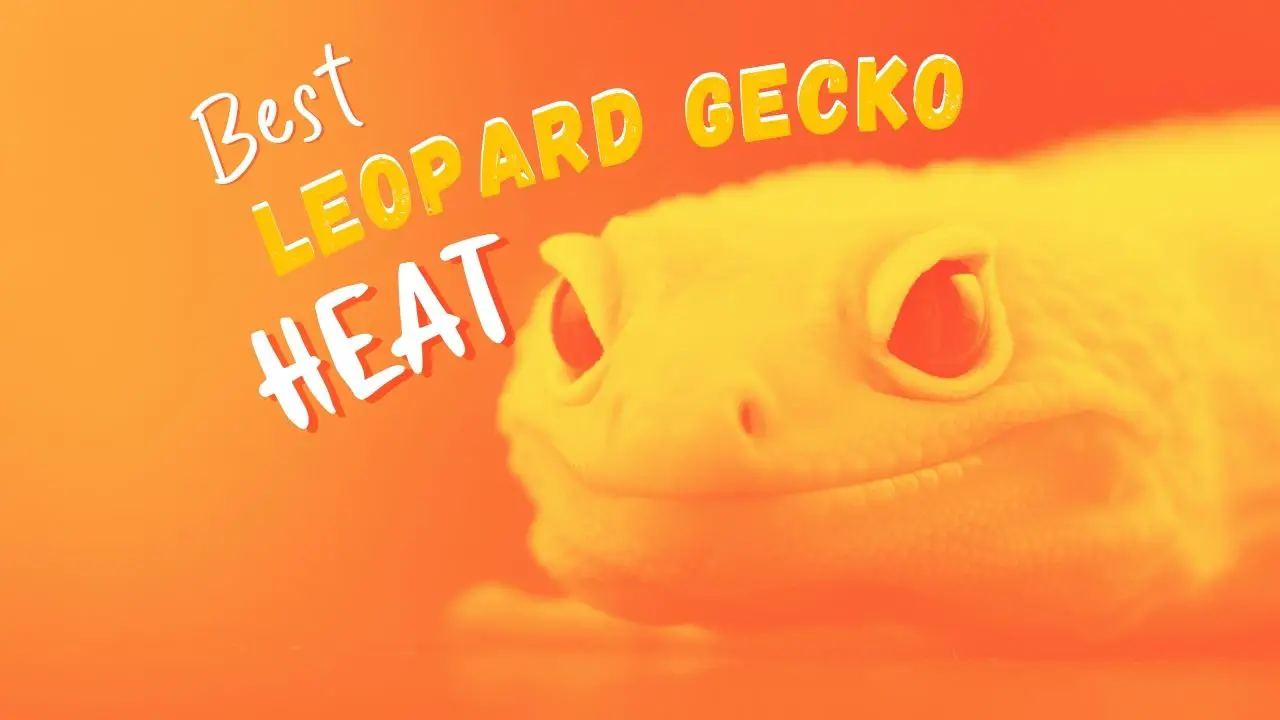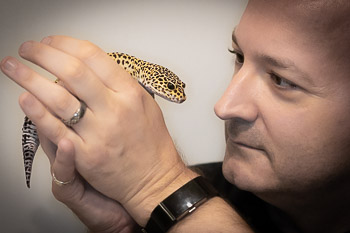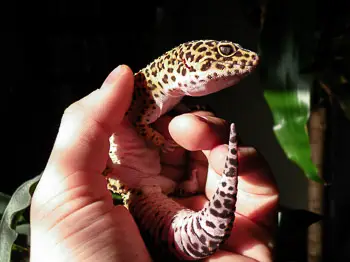As a responsible reptile owner, you want to make sure you’re providing a safe and healthy habitat. Different reptiles have different needs, so you want to make sure your pet’s environment is species appropriate.
Why do leopard geckos need heat?
Reptiles are ectothermic, or cold blooded, meaning their body temperature is determined by their environment and surroundings. In the wild, they depend on ambient air temperature, sunlight, absorbing heat from rocks, etc. for warmth. In captivity, they depend on the temperature of your home, lights or heat lamps, or under tank heaters.
What temperatures do leopard geckos need?
A leopard gecko enclosure should have temperatures between 80 °F (27 °C) and 90 °F (32 °C).
Having the correct temperatures is important, and having the heat where it is needed is equally important. There are two key elements to providing ideal temperatures for a leopard gecko:
- Temperature Gradient
- Belly Heat
Let’s look at some of the heating options available and see what works the best (and what mistakes to avoid.)
Should I use a heat mat for my leopard gecko?
An under the tank heat mat is a flat electric mat that, as the name implies, is placed under your tank. It’s basically a heating pad designed for reptile tanks. Under the tank heaters are one of the best ways to provide heat where your gecko needs it most.
A heat mat should be placed on one side of the tank only, to help create a hot and cool side of your gecko’s enclosure.
Some folks may argue that this does not do enough to regulate different temperature zones in your habitat, though we’ve never noticed a problem. If it’s a particularly hot day. Our gecko hangs out in his cave on the cool side, else he’s on the hot side soaking up the glorious belly heat from the under tank heater.
Heat Lamps
Leopard geckos do not typically bask. As they are active at night and will most likely be sleeping or in a hide for much of the day, they do not need UV light. A heat lamp can help maintain proper temperature, though is best when combined with a heat pad that gives constant heat from below.
Caution must be exercised with heat lamps, since they are designed for basking reptiles. If the temperature is not properly regulated or the heat source is too close, you may risk cooking your gecko with too much direct heat.
In any event, you do want to provide a light source to simulate a day and night cycle.
Ceramic Heat Emitters
Ceramic heat emitters (ceramic heat bulb) and heat mats serve a similar purpose, to produce radiant heat. For leopard geckos, the ceramic heaters will be less effective, since they would usually be mounted in an overhead light socket. Ceramic bulbs are best for adding heat to increase the ambient air temperature.
If you’re having trouble keeping the ambient temperature of the enclosure high enough, a ceramic heater may make a good supplemental source, but shouldn’t be the main source of heat for a leopard gecko.
Since leopard geckos absorb most of their heat from underneath, the ceramic heater would be a supplemental heat source. A heat mat will do a better job.
If the heat mat isn’t generating enough heat on its own, a ceramic heater may do well to provide a bit more warmth or help maintain an even temperature gradient.
One bonus to ceramic heaters is that you can use them at night, when a regular light bulb would throw off visible light and defeat the purpose of emulating a day/night cycle.
Should I use a heat rock?
No. I’d like to just leave it at that, plain and simple, but am happy to explain.
Heat rocks provide localized heat, meaning the rock is hot, but does little to warm the rest of the enclosure. Your lizard will need to sit on the rock to absorb the heat, and is at risk of being burned. The surface temperature of the rock may be more than what your gecko can handle. Heat rocks are especially a poor choice if they are the only heat source.
What is the best way to regulate heat for Leopard Geckos?
Regardless of your heat source, it’s best regulated by a thermostat. A thermostat lets you set and maintain a specific temperature for your heat source.
You’ll also need to measure the temperature. A digital thermometer with a temperature probe will be the most accurate. Note: to hit a specific temperature with a heat mat – say 90 F – you may need to set the thermostat a bit higher to hit the target temperature as some heat will be absorbed and dissipated by the tank and substrate. The thermometer will tell you what the actual temperature is.
This heat mat comes with a built in thermostat:


Which heat source is best?
An under the tank heat mat is a must have for a leopard gecko enclosure. Leopard geckos need heat from underneath to properly digest their food. A heat mat provides exactly what they need in this respect.
A thermostat can control your heat mat and make sure it’s providing the correct amount of heat. If you need more, you can use a ceramic heat emitter or heat lamp as a supplemental source of heat to raise the ambient air temperature.
Opinions may vary, but we feel at The Habitat, heat mats are our preferred option.
How do leopard geckos get heat in the wild?
Leopard geckos do not bask in the sun like many reptiles. They sleep most of the daylight hours and don’t see much direct sunlight. They indirectly get their heat from rocks that have warmed in the sun during the day.
Mimic heat sources in nature. Sunlight produces infrared light (IR-A and IR-B). Heat from sunlight is also stored in objects such as rocks, and reflected back as radiant heat.
Another more advanced approach is to set up a vivarium that mimics the natural habitats where leopard geckos live in the wild. You’ll need rocks and surfaces that can absorb and hold heat from the lights so they can provide radiant heat from underneath.
A deep heat projector is a light that will mimic the sun. This produces light which, in addition to providing the heat from the light, will also heat surfaces in the enclosure. This can be effective if you have tiles, rocks, or slate in your tank that can absorb and hold the heat so your leopard gecko is still getting heat from underneath.
What happens if my leopard gecko gets too hot?
If your enclosure gets too hot, your leopard gecko will try to move somewhere cooler to better regulate its body temperature. This is why it’s necessary to provide a range of temperatures within the enclosure.
If there is no cool spot in the tank, or it’s not cool enough, your pet may try to escape. You may see your leopard gecko “glass swimming.” Don’t worry; they can’t climb the glass, though this may be a sign that something is wrong and they are seeking someplace more comfortable. Double check you are providing the correct temperature range.
Heat lamps positioned too close or heat rocks that are too hot can cook your lizard.
Wrap Up – Heat Sources for Leopard Geckos
The key to providing a proper leopard gecko habitat is to make sure you have the proper tank temperatures. Regardless of what heating devices you use, make sure you’re providing a temperature gradient. This way your lizard can move from the hot to the cooler side to regulate its body heat.
Make sure your heating plans provide belly heat as your primary heat source. Your leopard gecko needs heat from underneath to not only stay warm, but to properly digest its food. This is most easily achieved with a heat mat placed under the tank.





